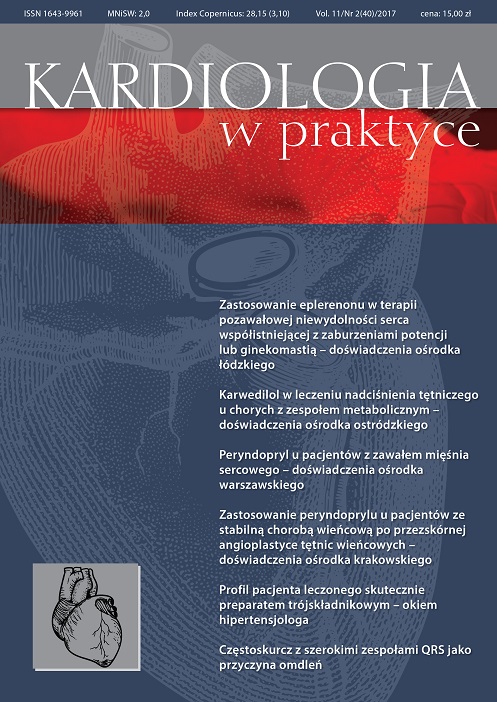Profile of the patient effectively treated with fixed-dose, triple-combination ternary preparation – hypertensiologist’s point of view Case report
Main Article Content
Abstract
An obese patient with poorly controlled hypertension was presented in article. Based on patients’ examinations and additional studies his cardiovascular risk was estimated. Fixed-dose, triple-combination drug was introduced in patients treatment, after earlier therapeutic modifications. Satisfactory blood pressure control has been achieved. Based on this case, a principles of hypotensive therapy were presented including benefits followed the use of fixed-dose combination drugs. The reasons of using of perindopril, amlodipine and indapamide were also discussed.
Downloads
Article Details

This work is licensed under a Creative Commons Attribution-NonCommercial 4.0 International License.
Copyright: © Medical Education sp. z o.o. This is an Open Access article distributed under the terms of the Attribution-NonCommercial 4.0 International (CC BY-NC 4.0). License (https://creativecommons.org/licenses/by-nc/4.0/), allowing third parties to copy and redistribute the material in any medium or format and to remix, transform, and build upon the material, provided the original work is properly cited and states its license.
Address reprint requests to: Medical Education, Marcin Kuźma (marcin.kuzma@mededu.pl)
References
2. Conlin P.R., Gerth W.C., Fox J. et al.: Persistence to antihypertensive drug classes throughout four years. Clin. Ther. 2001; 23: 1999-2010.
3. Dahlöf B., Sever P.S., Poulter N.R. et al.; ASCOT Investigators: Prevention of cardiovascular events with an antihypertensive regimen of amlodipine adding perindopril as required versus atenolol adding bendroflumethiazide as required, in the Anglo-Scandinavian Cardiac Outcomes Trial-Blood Pressure Lowering Arm (ASCOT-BPLA): a multicentre randomized controlled trial. Lancet 2005; 366: 895-906.
4. Dezii CM.: A retrospective study of persistence with single pill combination therapy vs. concurrent two-pill therapy in patients with hypertension. Management Care 2000; 9: 2-6.
5. Hansson L., Zanchetti A., Carruthers S.G. et al.: Effects of intensive blood-pressure lowering and low-dose aspirin in patients with hypertension: principal results of the Hypertension Optimal Treatment (HOT) randomized trial. Lancet 1998, 351: 1755-1762.
6. Jamerson K., Weber M.A., Bakris G.L. et al.; ACCOMPLISH Trial Investigators: Benazepril plus amlodipine or hydrochlorothiazide for hypertension in high-risk patients. N. Engl. J. Med. 2008; 359: 2417-2428.
7. Pall D., Szanto I., Szabo Z.: Triple combination therapy in hypertension: the antihypertensive efficacy of treatment with perindopril, amlodipine, and indapamide SR. Clin. Drug Investig. 2014; 34: 701-708.
8. Troth K.; PIANIST Investigators: Antihypertensive efficacy of triple combination perindopril/indapamide plus amlodipine in high-risk hypertensives: results of the PIANIST study (Perindopril-Indapamide plus AmlodipiNe in high rISk hypertensive patients). Am. J. Cardiovasc. Drugs 2014; 14: 137-145.
9. Tykarski A., Narkiewicz K., Gaciong Z. et al.: Zasady postępowania w nadciśnieniu tętniczym – 2015 rok. Wytyczne Polskiego Towarzystwa Nadciśnienia Tętniczego. Nadciśnienie Tętnicze w Praktyce 2015; 1: 1-70.
10. Widecka K., Grodzicki T., Narkiewicz K. et al.: Zasady postępowania w nadciśnieniu tętniczym – 2011 rok. Wytyczne Polskiego Towarzystwa Nadciśnienia Tętniczego. Nadciśnienie Tętnicze 2011; 15: 55-82.
11. Wytyczne ESH/ESC dotyczące postępowania w nadciśnieniu tętniczym w 2013 roku. Nadciśnienie Tętnicze 2013; 17(2): 69-168.

